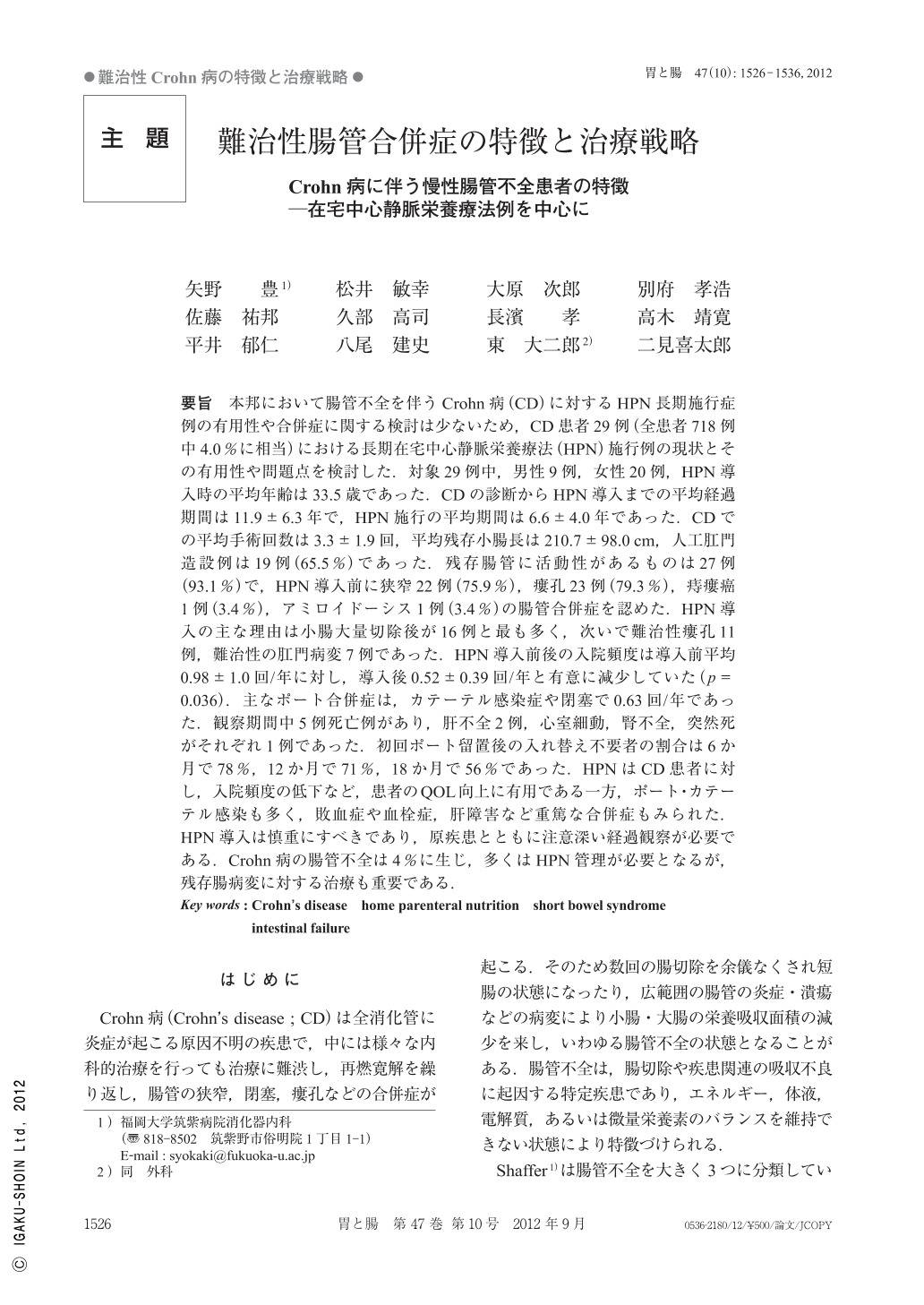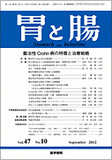Japanese
English
- 有料閲覧
- Abstract 文献概要
- 1ページ目 Look Inside
- 参考文献 Reference
- サイト内被引用 Cited by
要旨 本邦において腸管不全を伴うCrohn病(CD)に対するHPN長期施行症例の有用性や合併症に関する検討は少ないため,CD患者29例(全患者718例中4.0%に相当)における長期在宅中心静脈栄養療法(HPN)施行例の現状とその有用性や問題点を検討した.対象29例中,男性9例,女性20例,HPN導入時の平均年齢は33.5歳であった.CDの診断からHPN導入までの平均経過期間は11.9±6.3年で,HPN施行の平均期間は6.6±4.0年であった.CDでの平均手術回数は3.3±1.9回,平均残存小腸長は210.7±98.0cm,人工肛門造設例は19例(65.5%)であった.残存腸管に活動性があるものは27例(93.1%)で,HPN導入前に狭窄22例(75.9%),瘻孔23例(79.3%),痔瘻癌1例(3.4%),アミロイドーシス1例(3.4%)の腸管合併症を認めた.HPN導入の主な理由は小腸大量切除後が16例と最も多く,次いで難治性瘻孔11例,難治性の肛門病変7例であった.HPN導入前後の入院頻度は導入前平均0.98±1.0回/年に対し,導入後0.52±0.39回/年と有意に減少していた(p=0.036).主なポート合併症は,カテーテル感染症や閉塞で0.63回/年であった.観察期間中5例死亡例があり,肝不全2例,心室細動,腎不全,突然死がそれぞれ1例であった.初回ポート留置後の入れ替え不要者の割合は6か月で78%,12か月で71%,18か月で56%であった.HPNはCD患者に対し,入院頻度の低下など,患者のQOL向上に有用である一方,ポート・カテーテル感染も多く,敗血症や血栓症,肝障害など重篤な合併症もみられた.HPN導入は慎重にすべきであり,原疾患とともに注意深い経過観察が必要である.Crohn病の腸管不全は4%に生じ,多くはHPN管理が必要となるが,残存腸病変に対する治療も重要である.
Few studies have been conducted in Japan regarding the utility and complications of long-term HPN(home parenteral nutrition)for CD(Crohn's disease)with intestinal failure. The present study investigated the current state, utility and issues of long-term HPN in 29 CD patients, equivalent to 4.0% of 718 CD patients. Patient characteristics were as follows : 9 men and 20 women ; mean age at start of HPN, 33.5 years ; mean period between CD diagnosis and start of HPN, 11.9±6.3 years ; mean HPN duration, 6.6±4.0 years ; and, mean frequency of CD-related surgeries, 3.3±1.9 times, including ileostomy and colostomy in 19 patients(65.5%)with a mean residual small intestine length of 210.7±98.0 cm. Activity in the residual intestinal tract was present in 27 patients(93.1%). Intestinal tract complications prior to the start of HPN comprised stenosis, n=22(75.9%); fistula, n=23(79.3%); anal fistula cancer, n=1(3.4%); and, amyloidosis, n=1(3.4%). The most common primary reasons for HPN were massive small bowel resection(n=16), uncontrollable fistula(n=11)and refractory anal lesions(n=7). The mean frequency of hospitalization significantly decreased following the start of HPN, from 0.98±1.0 times/year before starting to 0.52±0.39 times/year after starting(p=0.036). The main port-related complications comprised catheter infection and blockage, occurring at a mean of 0.63 times/year. During follow-up, 5 patients died, 2 patients experienced liver failure, and ventricular fibrillation, renal failure and sudden death were each suffered by 1 patient, respectively. Substitution following initial port placement was unnecessary for 78% of patients at 6 months, 71% at 12 months, and 56% at 18 months. Although HPN decreased hospitalization frequency and improved quality of life for CD patients, a high incidence of catheter infection and serious complications such as septicemia, thrombosis and hepatic dysfunction were also observed. HPN should be introduced with caution and careful follow-up of both the primary disease and HPN is required. Intestinal failure arises in 4% of CD cases and although HPN management is often necessary, treatment for residual bowel lesions is also important.

Copyright © 2012, Igaku-Shoin Ltd. All rights reserved.


